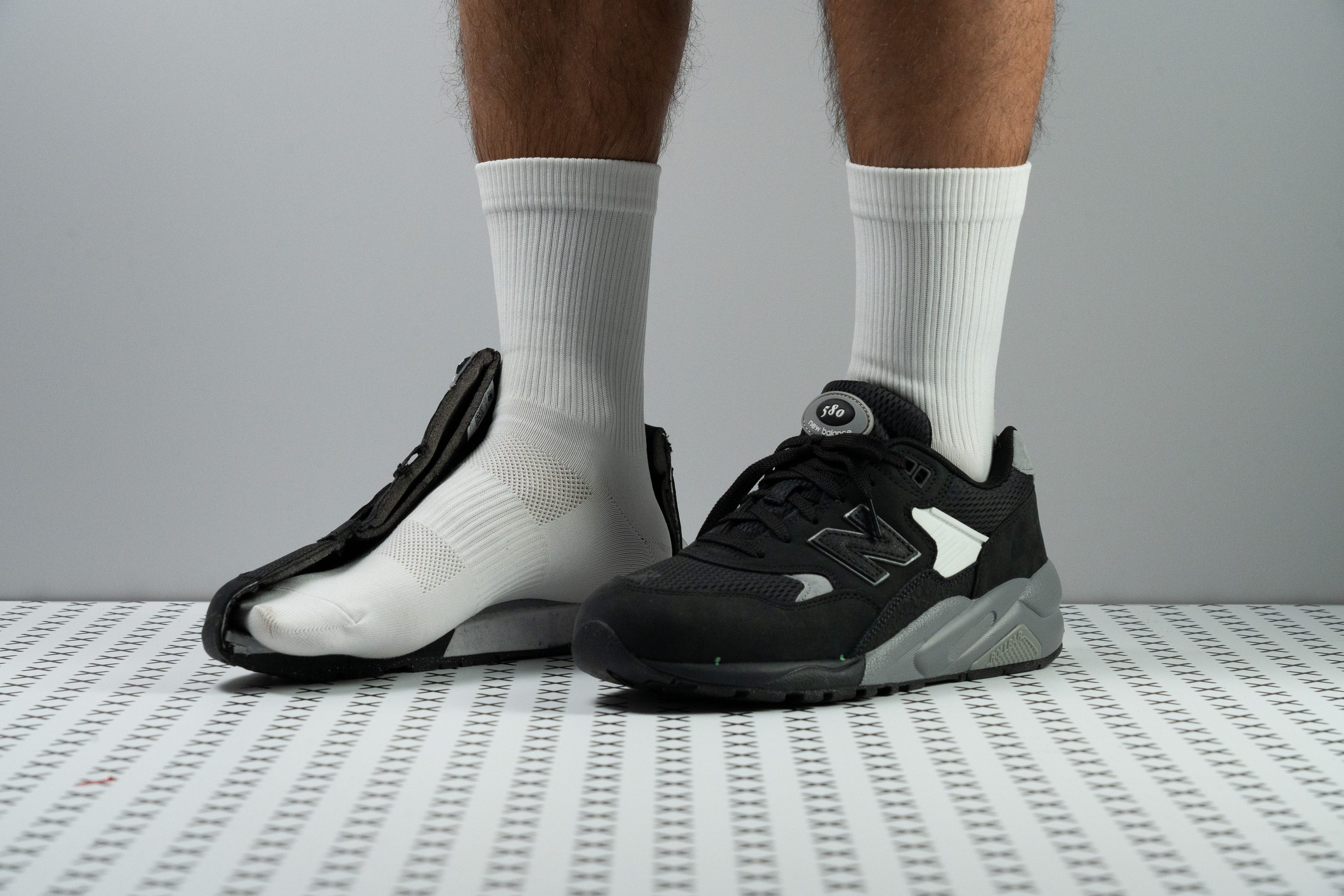Our verdict
- Top pick in best summer trainers
Pros
- Luxuriously comfortable
- Well cushioned landings
- Among NB's most stylish
- Extremely breathable
- Stable and supportive ride
- Good for some fitness activities
- World-class finish
- Premium parts
- Premium parts
Cons
- Not for wide feet
- Subpar colour retention
Audience verdict
Comparison
The most similar trainers compared
+ + Add a shoe | |||||
|---|---|---|---|---|---|
| Audience score | 87 Good! | 87 Good! | 93 Great! | 88 Good! | |
| Price | £170 | £210 | £160 | £110 | |
| Style | ClassicRetroSportyChunky | ClassicSporty | ClassicSportyFuturisticChunky | RetroSporty | |
| Shock absorption | - | - | Moderate | - | |
| Energy return | - | - | Moderate | - | |
| Traction | - | - | High | - | |
| Breathability | Breathable | Breathable | Moderate | Breathable | |
| Weight lab | 14 oz / 397g | 13.9 oz / 393g | 15.1 oz / 427g | 14 oz / 397g | |
| Size | True to size | True to size | True to size | True to size | |
| Midsole softness | Balanced | Balanced | Soft | Balanced | |
| Material | LeatherMeshSuede | LeatherMeshSuede | MeshSuede | MeshSuede | |
| Season | Summer | SpringFall | SpringFall | SpringFall | |
| Inspired from | Running | Running | Running | Running | |
| Width / fit | Medium | Medium | Medium | Medium | |
| Toebox width | Medium | Medium | Narrow | Medium | |
| Leather/suede quality | Real leather | - | Real suede | Real suede | |
| Toebox durability | Decent | Decent | Decent | Good | |
| Heel padding durability | Decent | Bad | Decent | Decent | |
| Outsole durability | Good | Good | Good | Good | |
| Heel stack lab | 34.8 mm | 34.1 mm | 37.3 mm | 33.5 mm | |
| Stiffness | Stiff | Moderate | Moderate | Stiff | |
| Tongue padding | Average | Average | Average | Average | |
| Drop lab | 10.3 mm | 14.5 mm | 11.3 mm | 10.8 mm | |
| Forefoot | 24.5 mm | 19.6 mm | 26.0 mm | 22.7 mm | |
| Removable insole | ✓ | ✓ | ✓ | ✓ | |
| Heel tab | None | None | None | None | |
| Torsional rigidity | Stiff | Moderate | Moderate | Stiff | |
| Heel counter stiffness | Moderate | Moderate | Moderate | Stiff | |
| Reflective elements | ✓ | ✓ | ✓ | ✗ | |
| Closure | Laces | Laces | Laces | Laces | |
| Top | Low top | Low top | Low top | Low top | |
| Ranking | #105 Bottom 13% | #106 Bottom 12% | #22 Top 19% | #102 Bottom 15% | |
| Popularity | #82 Bottom 32% | #67 Bottom 44% | #1 Top 1% | #93 Bottom 23% |
Who should buy
We recommend the New Balance 580 as a great choice for:
- Those who prioritise comfort and want a luxuriously comfortable kick for their jaunts about town
- Retro aficionados in the market for a New Balance kick with a timeless, old-school design
- Sporty folks who need a stable yet well-cushioned shoe that can take on some fitness activities
- Style-minded individuals looking for a versatile and stylish shoe that will work with lots of outfits
- Those in warmer climates who need a breathable shoe to avoid sweaty feet

Who should NOT buy
Those with broad feet might find the 580's toebox a little too snug for comfort, especially after days with lots of walking. We recommend looking into the NB 530 as a roomier alternative with a similarly vintage vibe.
The 580's porous upper mesh and genuine leather overlays make it a less-than-ideal choice in places where it rains very frequently. There is a Gore-Tex model of the shoe that is entirely waterproof as an option. Alternatively, the NB 9060 is a relatively breathable shoe that makes a better year-round partner.

Cushioning
Heel stack
The 580 boasts a robust stack that's 34.8 mm thick at the heel according to our caliper measurements. This is higher than our current lab average and gives us a good amount of foam underfoot to effectively baffle impact and protect our heels.
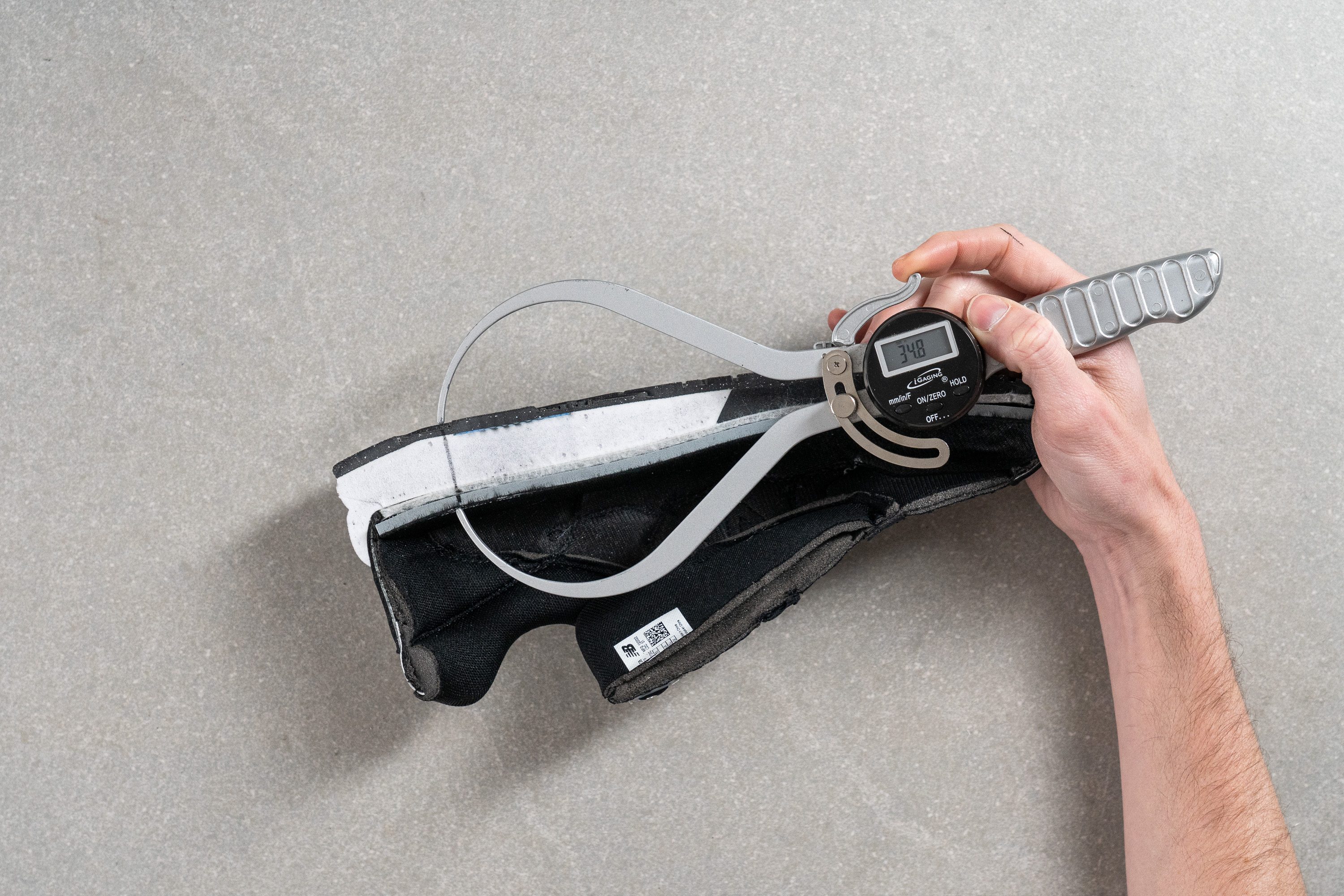
| 580 | 34.8 mm |
| Average | 30.7 mm |
Forefoot stack
The forefoot stack is also higher than average at 24.5 mm thick according to our caliper. Having so much supportive and protective cushioning underfoot means that, even after long days on our feet, we never dealt with achy joints or shin splints with this sneaker.
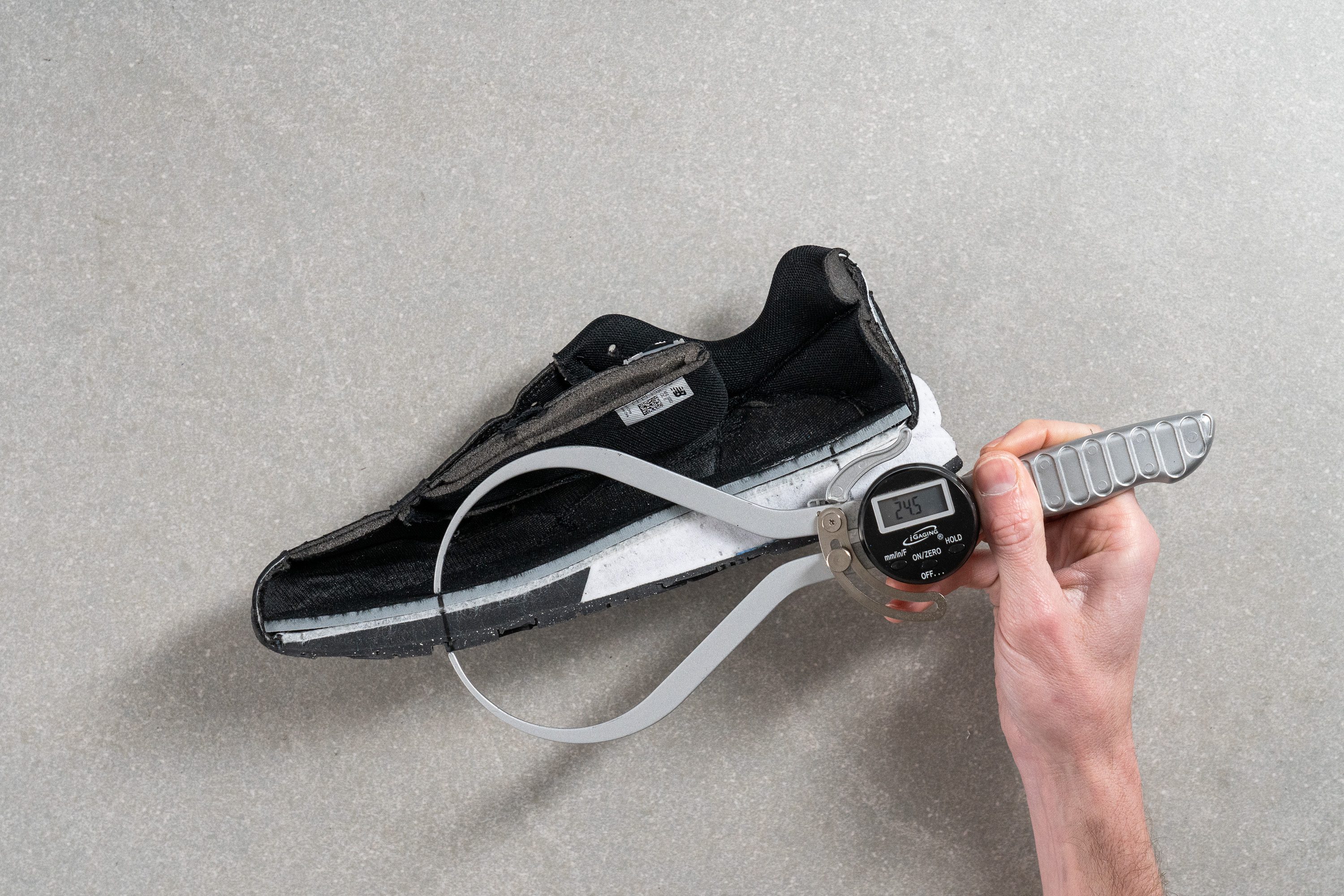
| 580 | 24.5 mm |
| Average | 19.5 mm |
Drop
The difference in our stack measurements leaves the 580 with a heel drop of 10.3 mm. This offset isn't too jarring as the elevated heel provides good protection during landings and promotes smooth transitions.
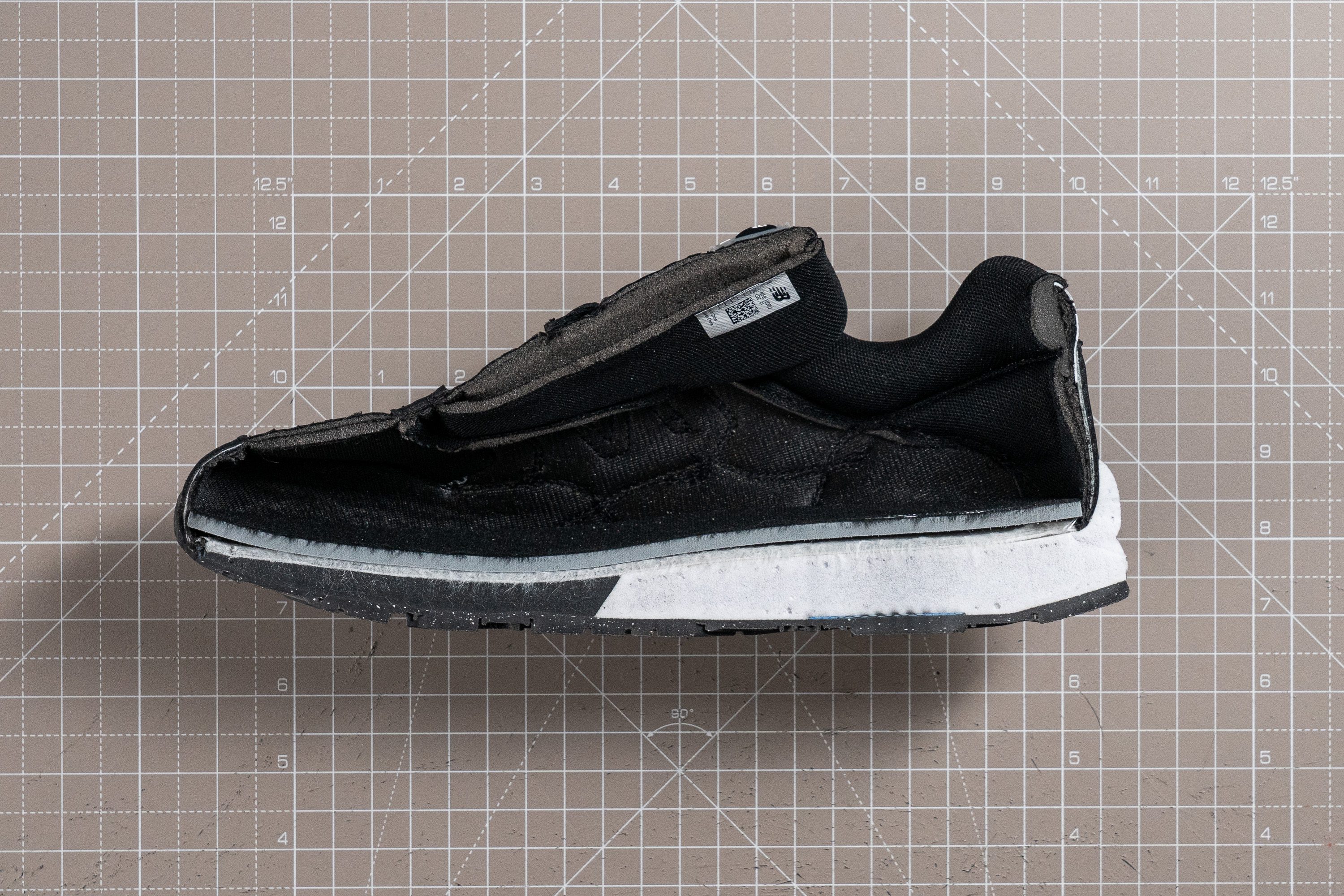
| 580 | 10.3 mm |
| Average | 11.2 mm |
Midsole softness
Pressing our durometer against the 580's midsole foam yields a rather plush reading of 20.3 HA. This, in tandem with the well-padded interior, plays a massive role in how comfortable this shoe feels underfoot.
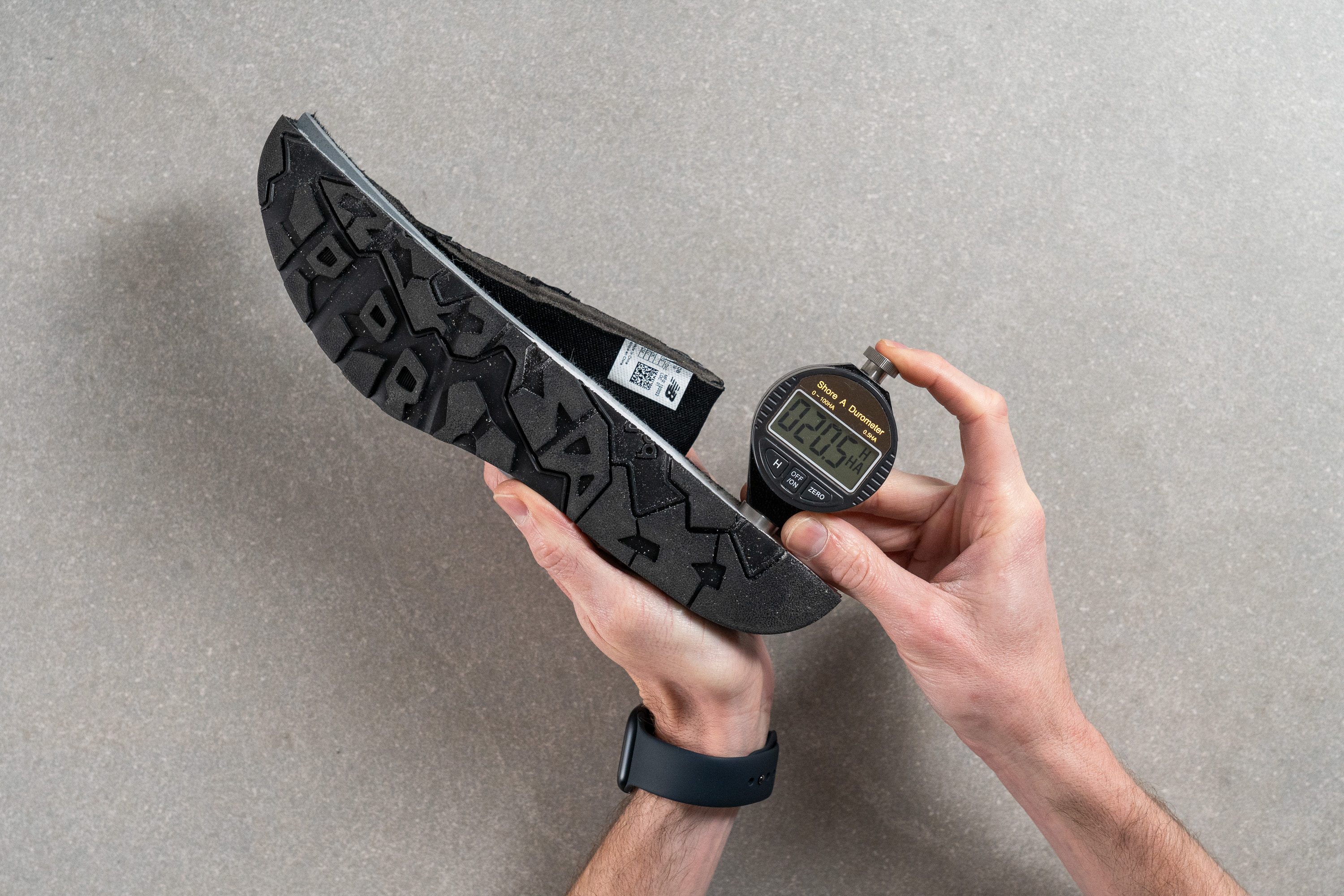
While the midsole doesn't compress too drastically, the high stack allows us to really savour cushioning with every stride without being too squishy. This in combination with the raised sidewalls that envelope our feet within the midsole gives us a ride that feels cushy as well as stable.
While its weight and lack of energy return preclude it from being an efficient dedicated running shoe, this level of cushioning means that the 580 feels quite comfortable when we take it out for some light running, whether around the block or on the treadmill.
| 580 | 20.3 HA |
| Average | 28.6 HA |
Size and fit
Size
New Balance 580 fits true to size (15 votes).
Width / Fit
To check how the fit of this New Balance sneaker stacks up against the average, we filled its interiors with custom gel and waited for the mould to freeze solid.
Next, we measured the widest part of the mould with a digital calliper. At 91.3 mm, it is pretty close to our current lab average, but it might still be too narrow for those with broad feet.
On the positive side, however, the combination of a relatively snug toebox on a wider platform gave our foot a nice locked-in feeling that further adds to the shoe's stable ride.
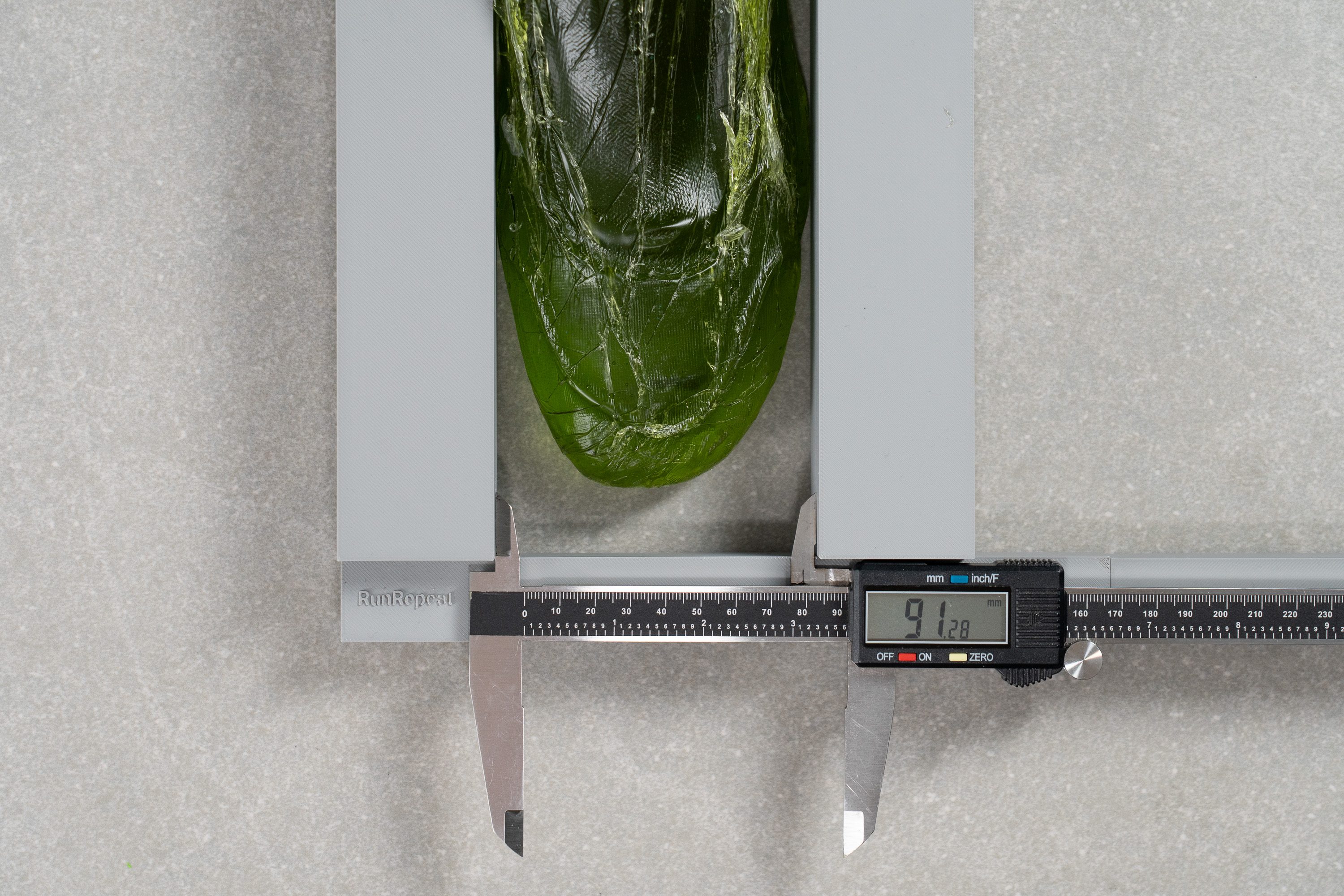
| 580 | 91.3 mm |
| Average | 92.5 mm |
Toebox width
Up at the big toe, the 580's toebox turned out to be in line with the average at 68.8 mm. This gave our toes a fair amount of room to splay out naturally without butting up against the toebox. Hotspots weren't one of our concerns while testing this shoe.
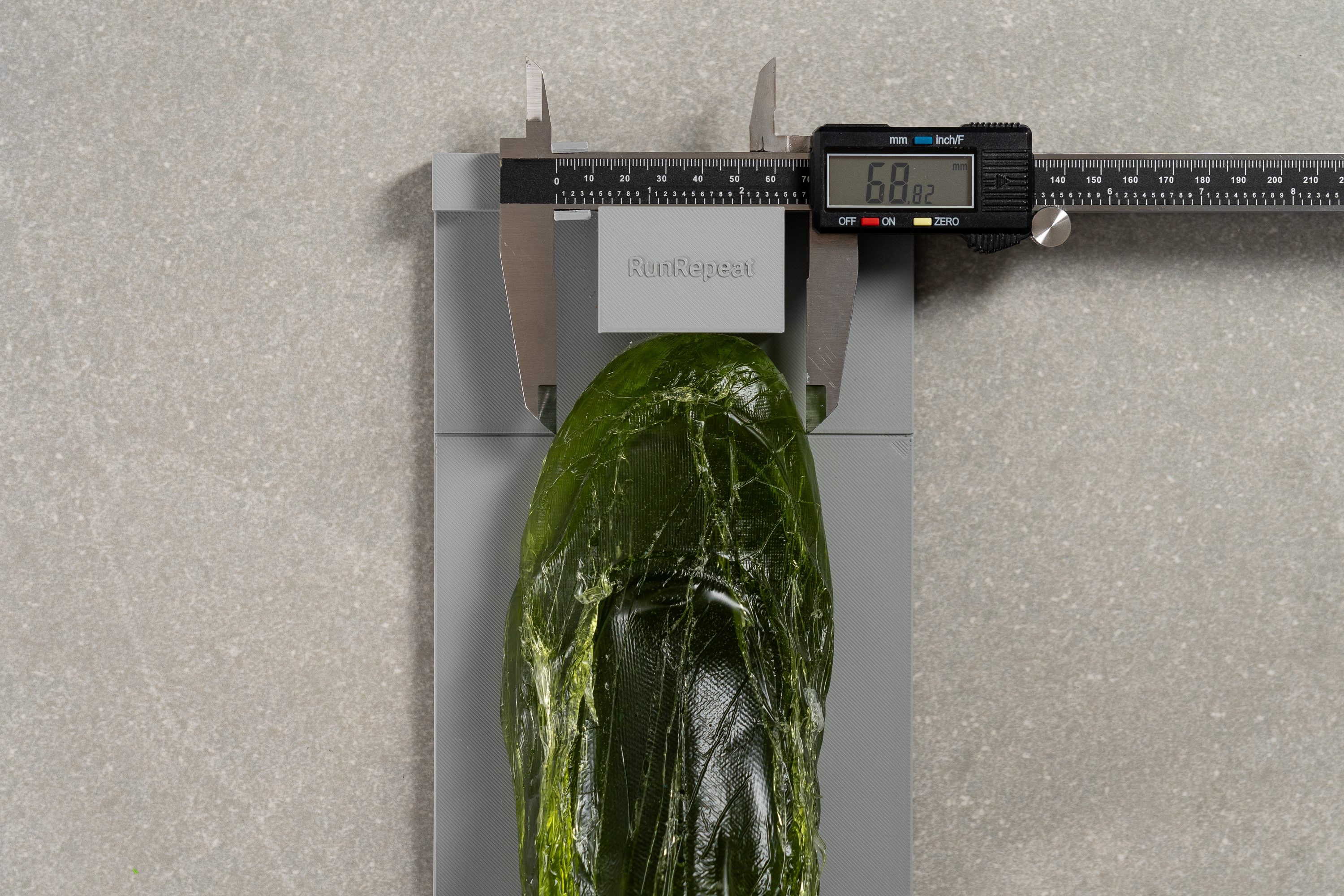
| 580 | 68.8 mm |
| Average | 68.9 mm |
Toebox height
A generous vertical space of 30.3 mm also contributes to the shoe's accommodating fit.
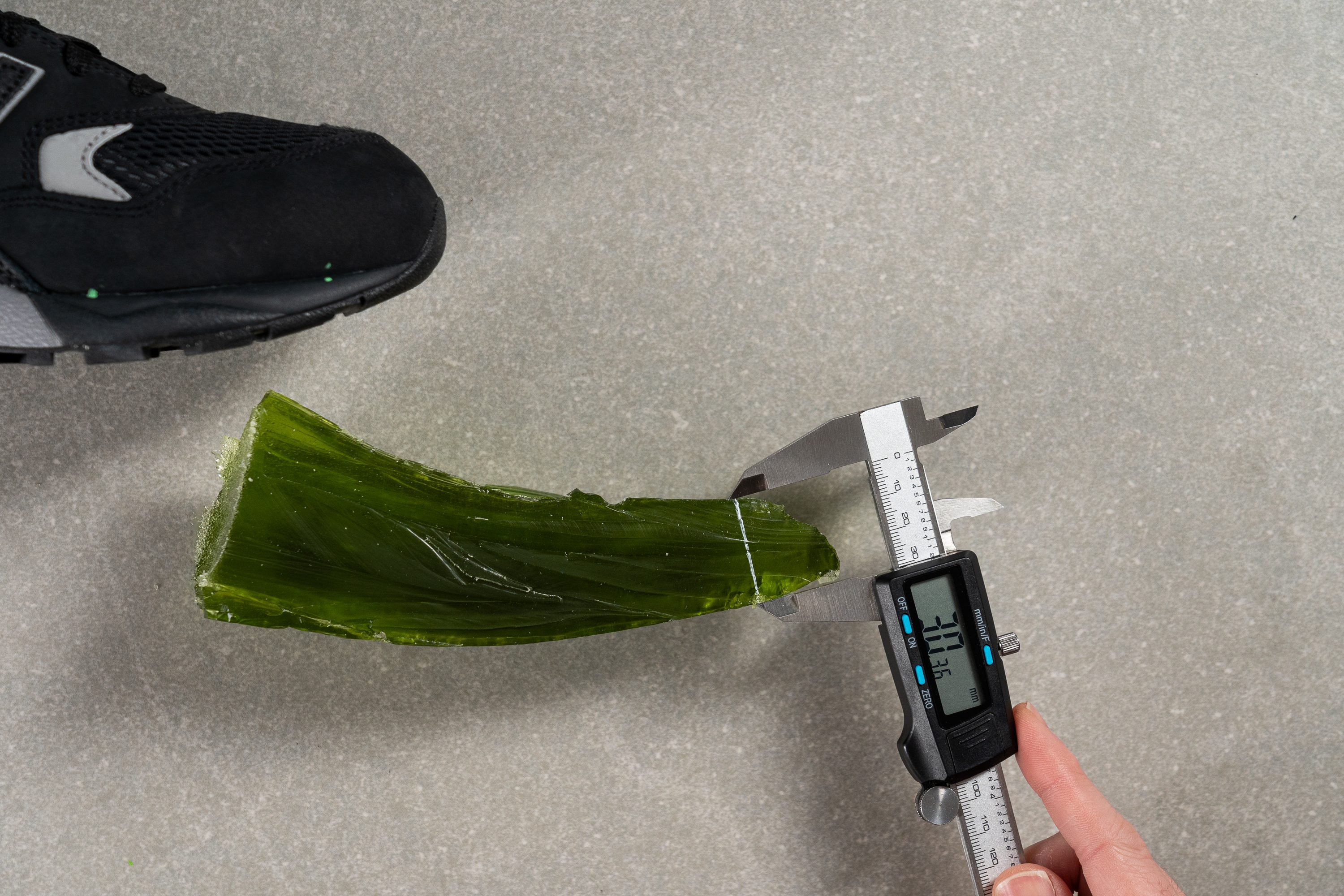
| 580 | 30.3 mm |
| Average | 27.8 mm |
Flexibility / Stiffness
We secured the 580 to our workbench and used a force gauge to torque it 90 degrees, finding that 30.5N of force was needed to get the shoe to the desired point.
This makes the 580 stiffer than the average shoe. However, while the shoe does resist the natural flexion of our foot to a certain extent, it isn't so stiff as to feel too uncomfortable underfoot. Rather, this resistance ends up feeling quite supportive underfoot and further contributes to the shoe's stable ride.
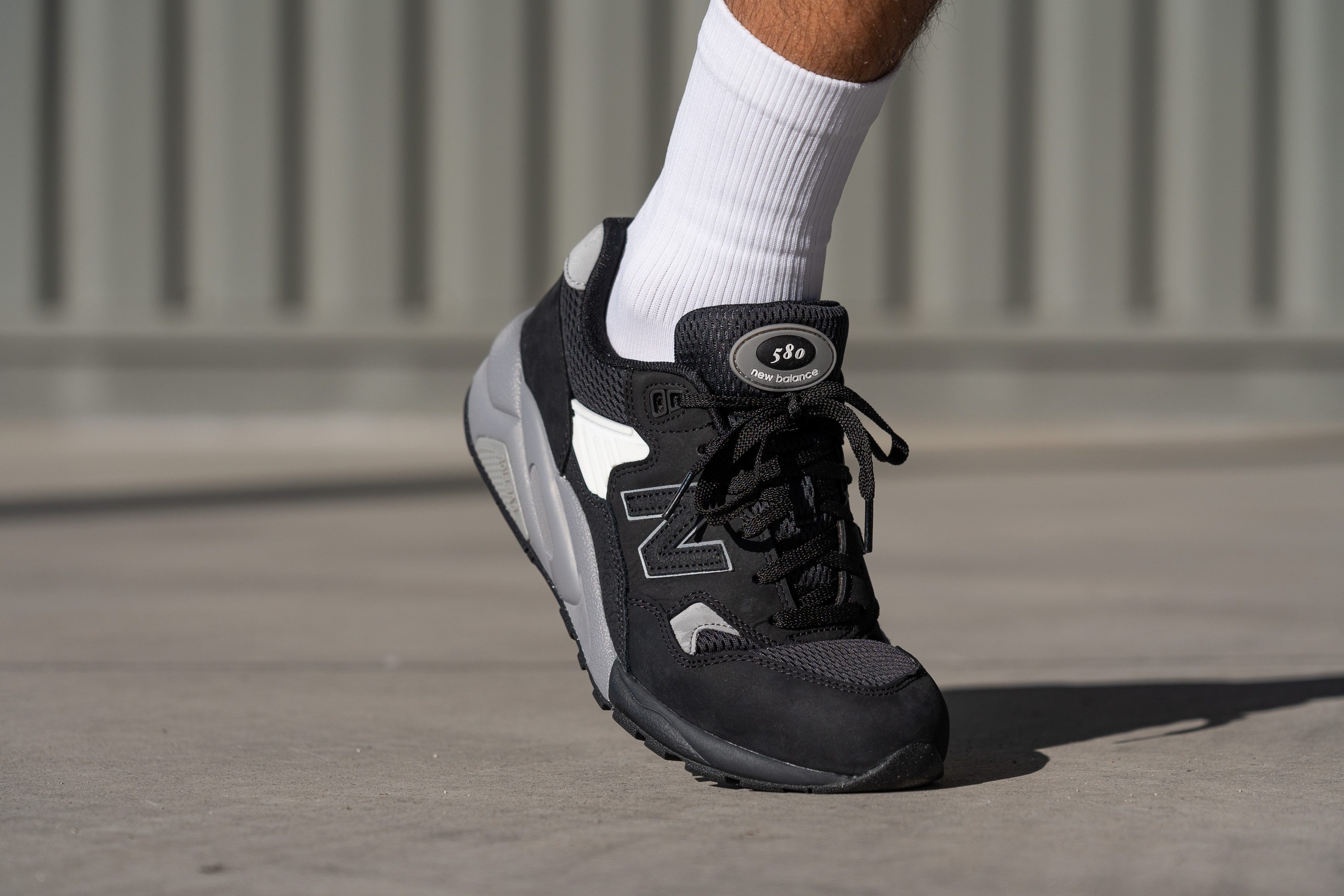
This test follows an older methodology, which is why you don't see recently tested shoes in the chart. Results from different methodologies can not be compared.
| 580 | 30.5N |
| Average | 23.3N |
Weight
Tipping the scale at 14 oz (397g), the 580 is about as heavy as the average sneaker. As such, the shoe feels quite natural and comfy underfoot for all of our day-to-day activities.
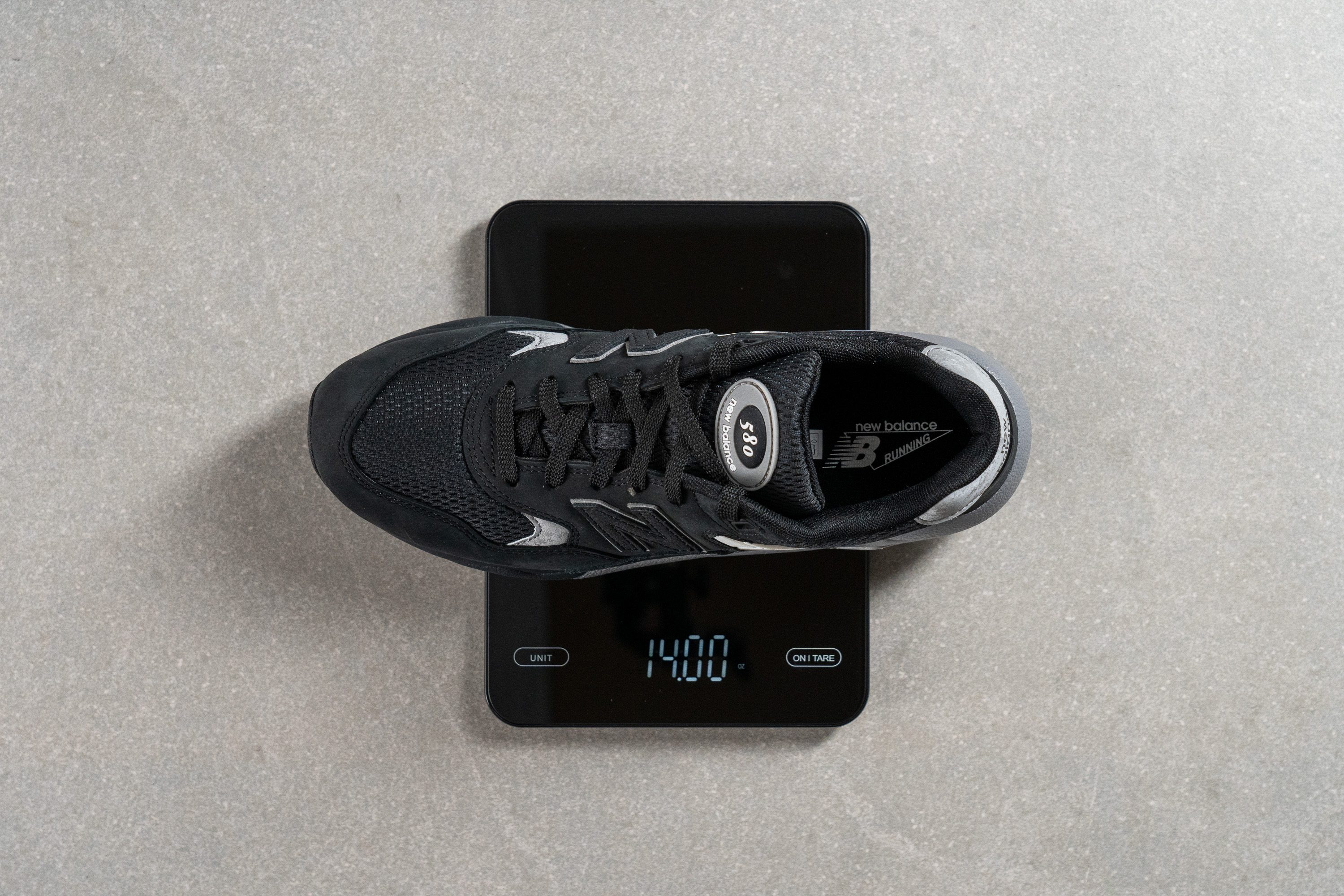
However, while this does work for certain fitness activities, this chunkiness makes it less than ideal for more intense activities like high-paced or long-distance runs.
| 580 | 14.0 oz (397g) |
| Average | 13.8 oz (390g) |
Breathability
We pumped the 580 full of smoke to get a visual idea of how breathable it is and, as the footage clearly demonstrates, this kick is an undeniable smoke show! The whole upper acts as a chimney letting out plumes of smoke, earning the 580 a perfect 5 out of 5 on this test. As such, the shoe keeps our feet cool and breezy even on warm summer days, not to mention keeps bad odours at bay.
Inspecting a backlit cross-section of the 580 yields a counter-intuitive result as the light isn't able to shine through the clearly porous mesh. Usually, shoes that block out the light like that score quite low on our breathability scale.
Our microscope image of the upper gives us a clearer understanding of this contradictory nature. As we can see, the upper is made up of two layers of mesh; the outer one is comprised of uniform braids woven to form openings that reveal the less dense lower layer of intertwined fibres. This construction leaves the upper with lots of gaps that promote airflow while creating a seemingly cohesive mesh that is more opaque than expected.
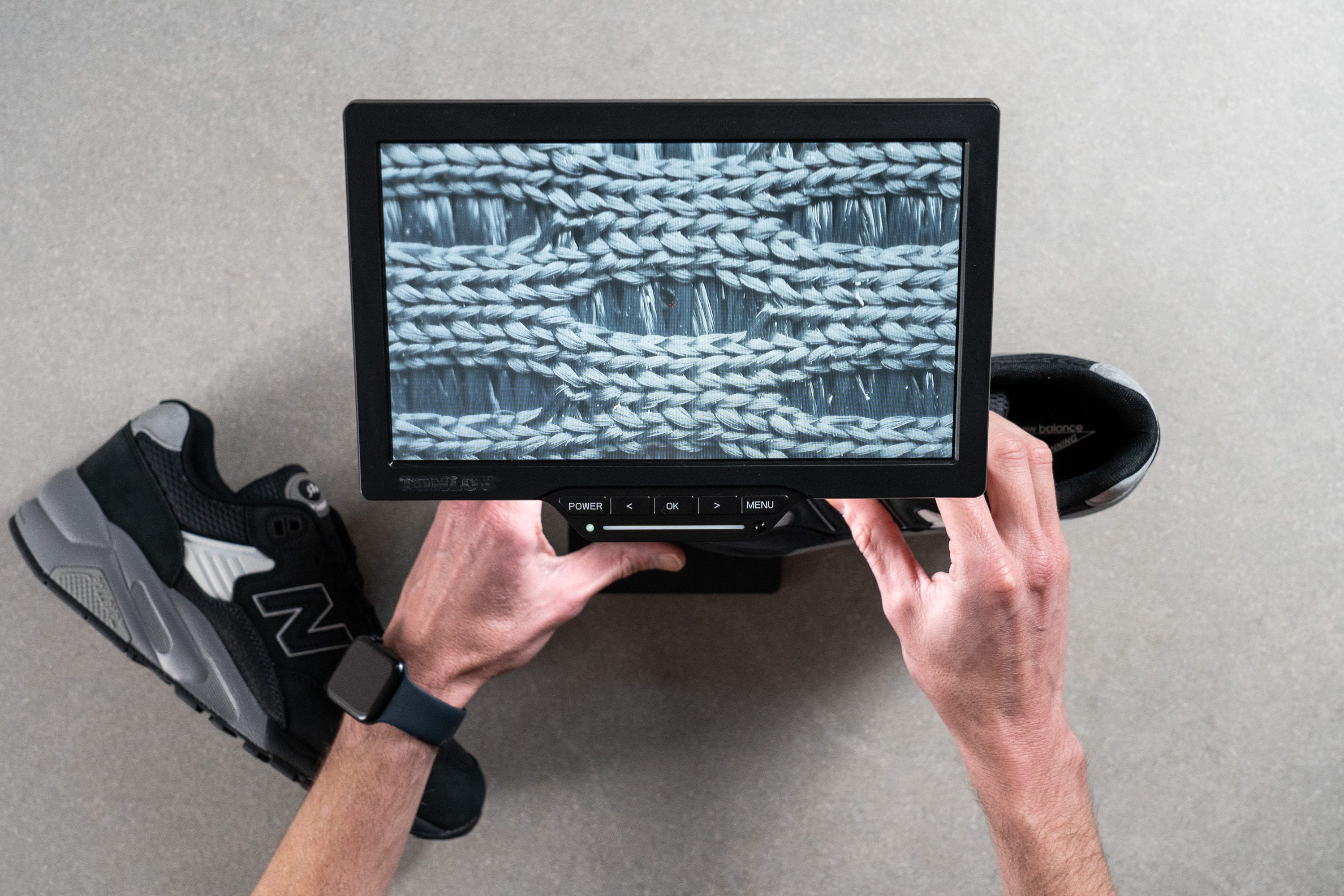
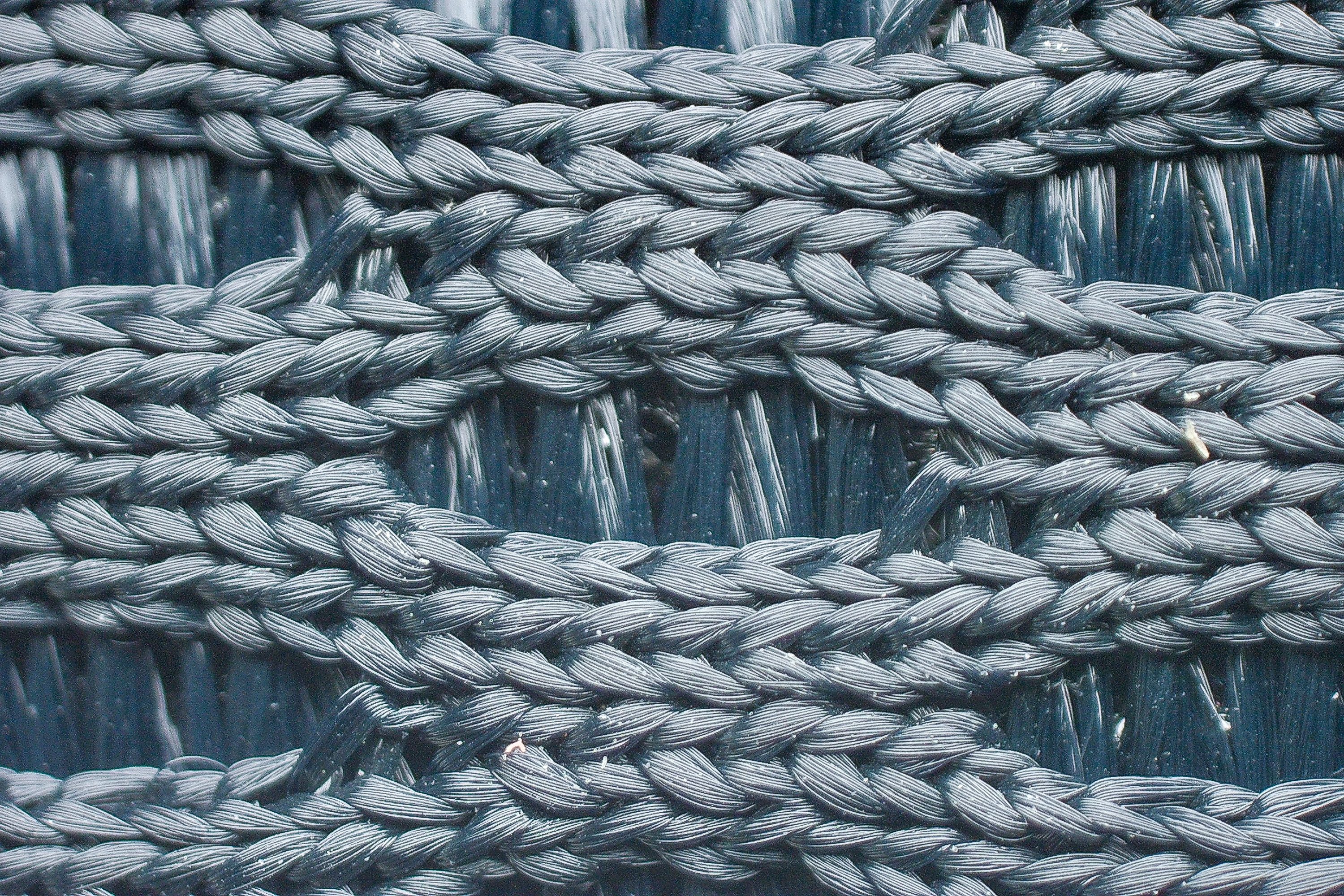
| 580 | 5 |
| Average | 3 |
Stability
Lateral stability test
Thanks in great part to the RollBar technology embedded in the midsole, the 580 manages to curtail any excessive lateral movements of our foot. In this way, it feels like a stability shoe in the way it helps us maintain a more neutral stride. This makes the 580 a good choice for those with overpronating strides who need a supportive shoe for their more active days.
Torsional rigidity
The key to the stability of the 580 is its high level of torsional rigidity which we scored 5 out of 5 on our subjective scale. This is because we were barely able to get the shoe to budge as we attempted to bend and twist it in our hands, with the rear of the shoe imbued with the RollBar technology feeling especially stiff. As such, the shoe resists the natural pronation of our foot during our stride and maintains a sturdy and level base that promotes surefooted and stable landings.
| 580 | 5 |
| Average | 3.6 |
Heel counter stiffness
The heel counter is moderately stiff, earning a score of 3 out of 5 in our manual assessment. This provides us with a good balance of comfort and stability as the counter holds our heel in place without putting too much pressure on our tendons.
What's more, the incredible amount of padding at the heel helps us achieve a secure rearfoot lockdown that feels incredibly comfy and forgiving even after having the shoe on for an extended period.
| 580 | 3 |
| Average | 3.2 |
Midsole width - forefoot
We measured the 580's midsole to be 112.1 mm, making it ever so slightly wider than our current lab average. This gives us a broad enough platform that we never felt wobbly while testing this kick.
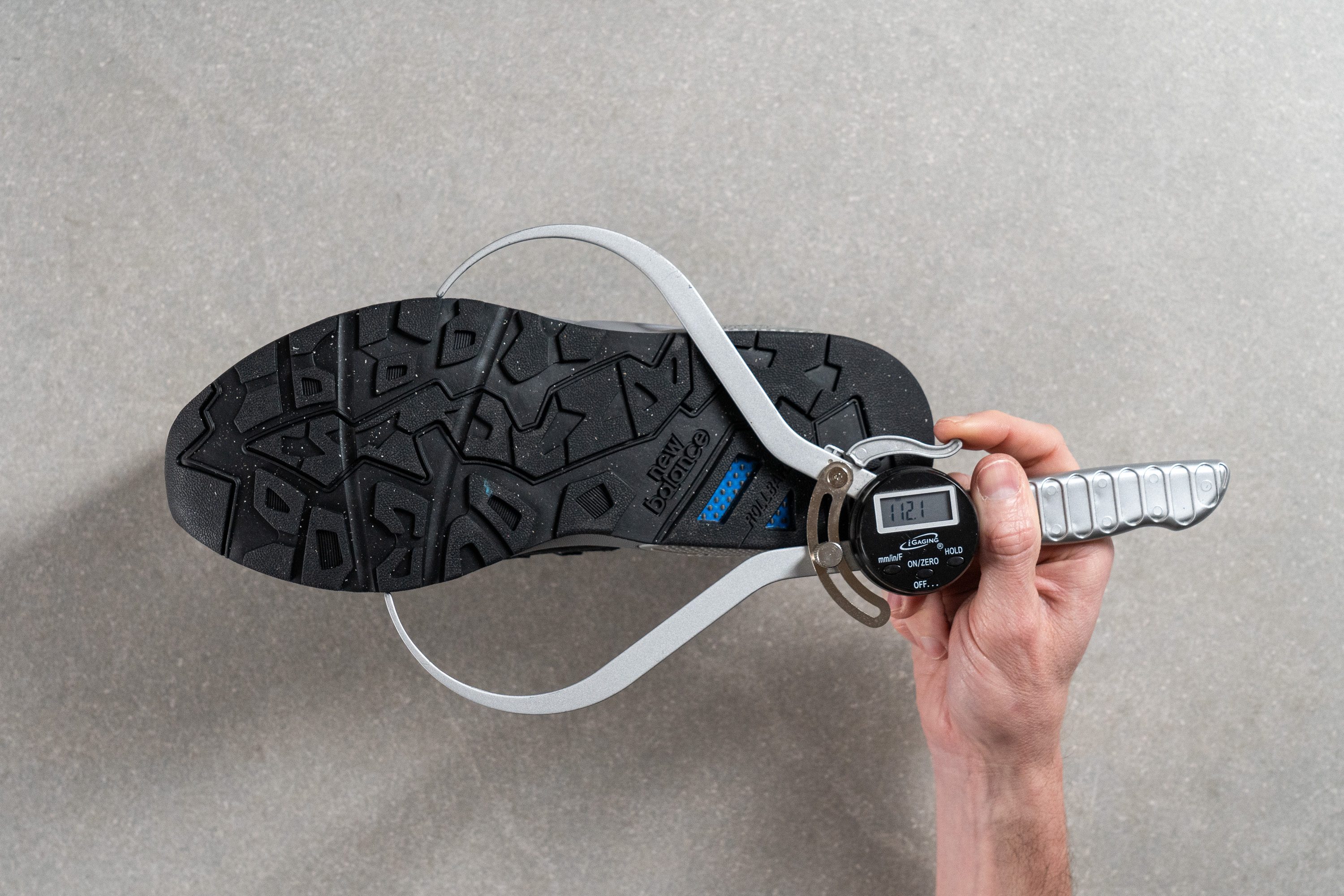
| 580 | 112.1 mm |
| Average | 108.9 mm |
Midsole width - heel
The midsole is about as wide as average at the heel at 83.8 mm wide. This base is also broad enough that we enjoyed stable and secure landings while walking around in the 580.
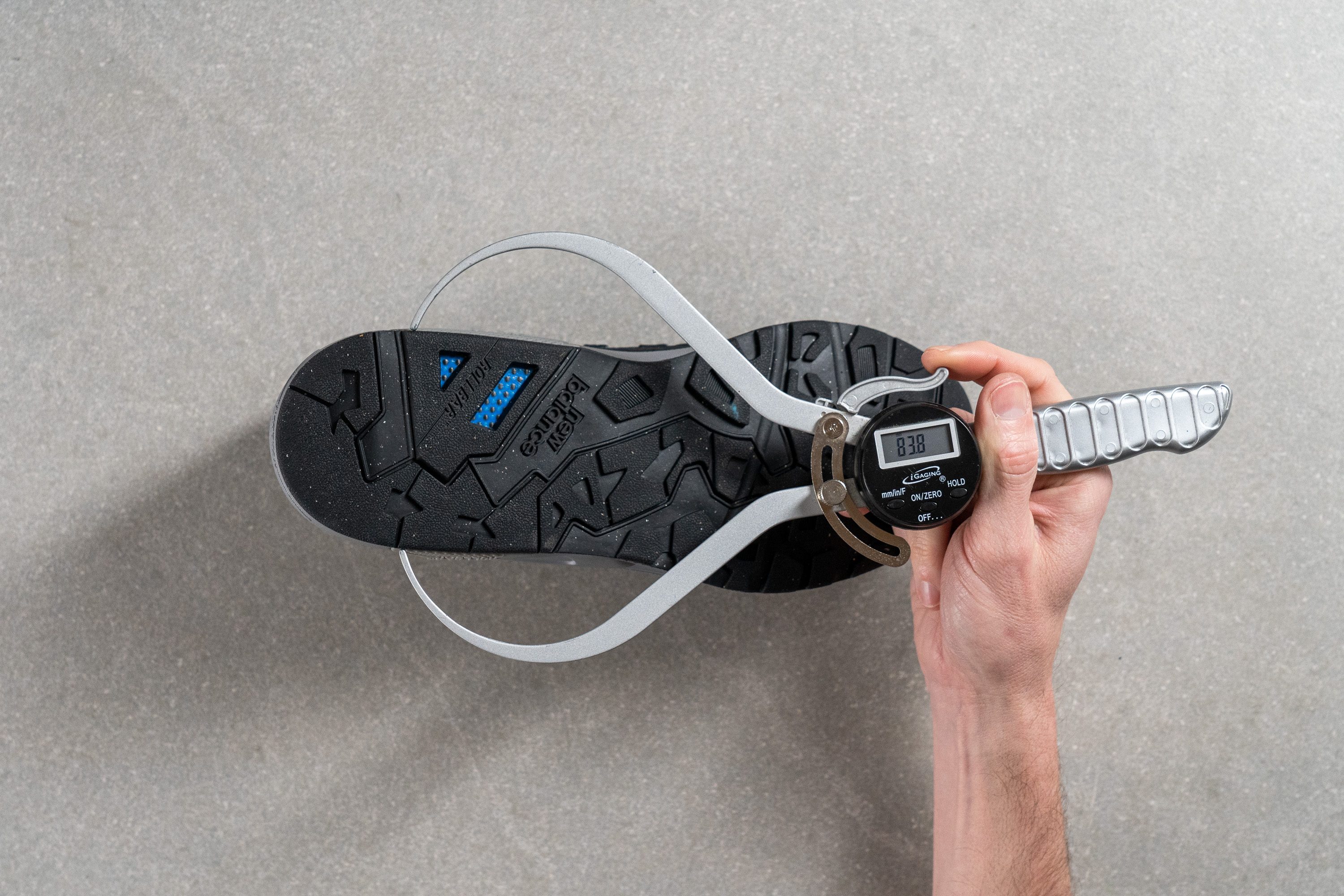
| 580 | 83.8 mm |
| Average | 84.0 mm |
Durability
Leather/Suede quality
Using a hand-held blow torch, we gave the 580's overlays the creme brulee treatment and scratched at the scorched remains with our awl. The way the outer layer burns and flakes off at the touch of our tool leads us to conclude that the leather used is genuine.
| 580 | Real leather |
Toebox durability
Usually, breathable mesh uppers don't fare well against our Dremel so we didn't hold out much hope as we fired it up to 5K RPM and set it against the unreinforced portion of the 580's toebox with 3.2N of force.
While it did kick up a flurry of material, we were pleasantly surprised to find that our tool had only managed to menace the outer layer of mesh, leaving the toebox relatively intact after the four-second test. This admirable performance leads us to give the 580 a toebox durability score of 4 out of 5. Considering there's also a protective overlay at the toes, we think that the toebox will survive any number of bumps, scrapes, and snags over this kick's lifetime.
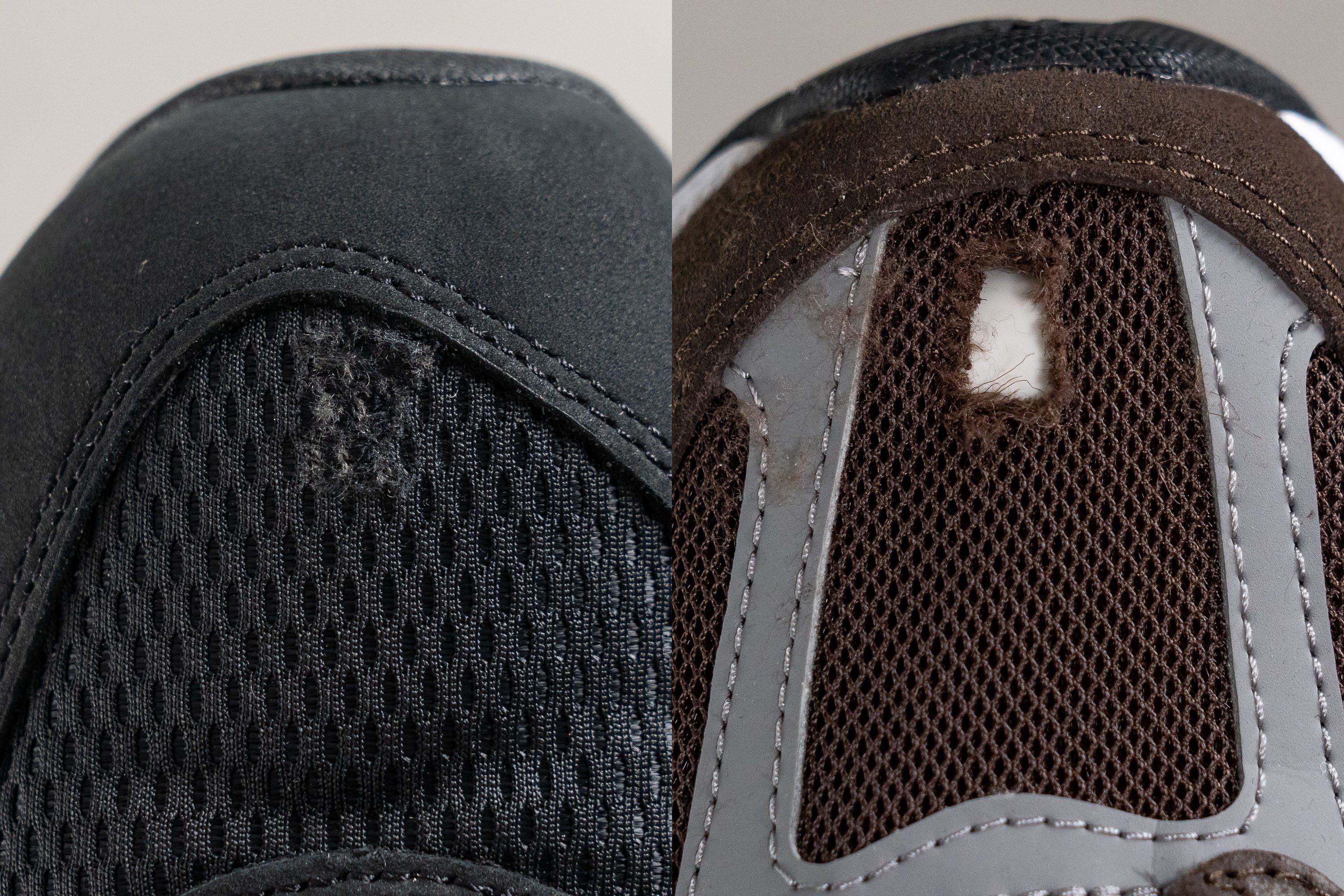
For comparison's sake, the NB 530's upper mesh is also breathable but took a major beating at the hands of our Dremel.
| 580 | 4 |
| Average | 3.7 |
Heel padding durability
The heel collar also proved to be a worthy adversary to our Dremel which wasn't able to go too far beyond the lining material, leaving the padding within relatively intact.
As such, the 580 earns a 4 out of 5 for heel padding durability which means that the constant friction of heel rubs isn't likely to do much damage over the shoe's lifetime.
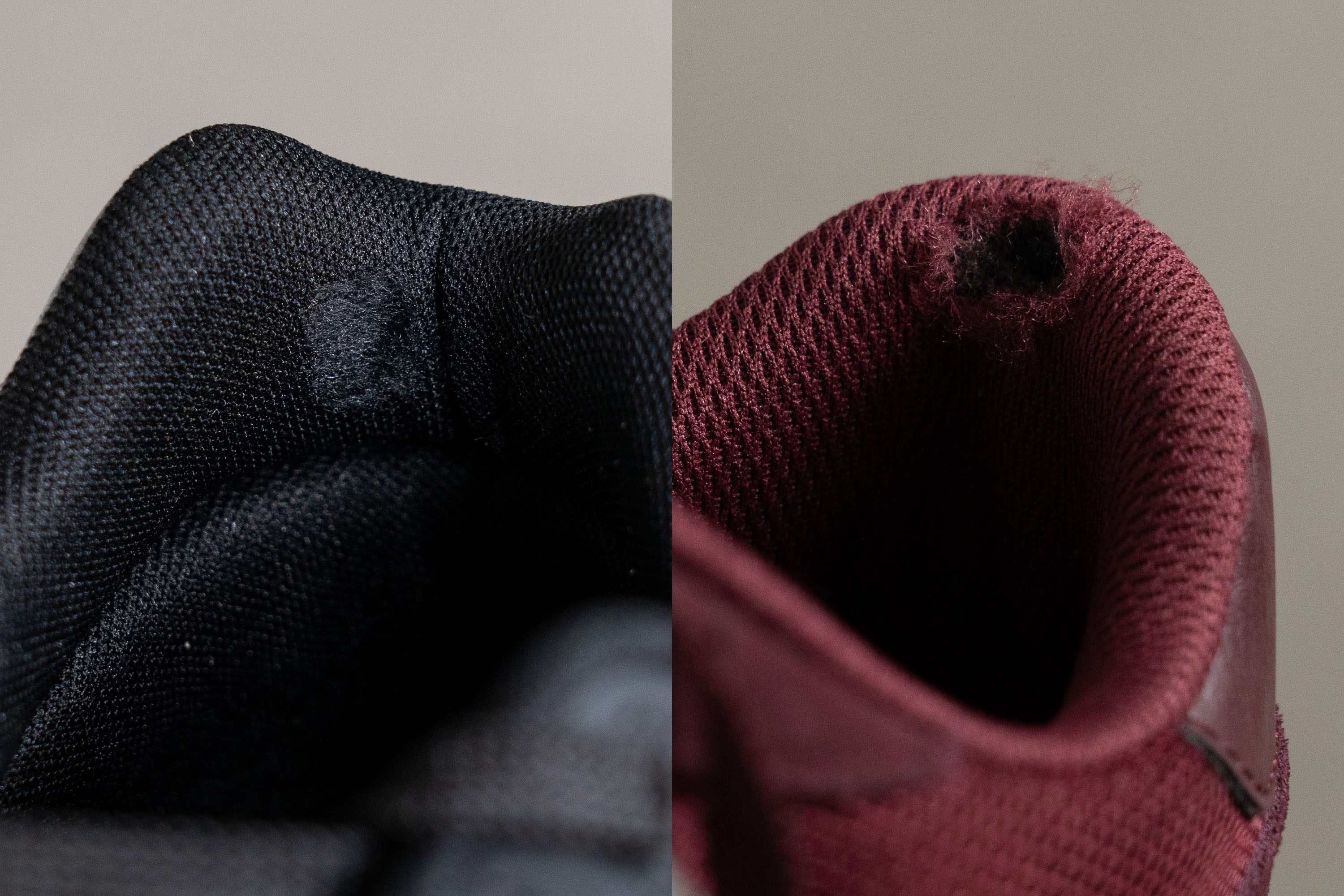
The 580 outperforms another one of its cousins, the NB 237, which was left with quite the crater after this same test.
| 580 | 4 |
| Average | 3.2 |
Outsole hardness
The 580's outsole is a little harder than average with a durometer reading of 88.6 HC. This usually denotes a good balance of grip and durability.
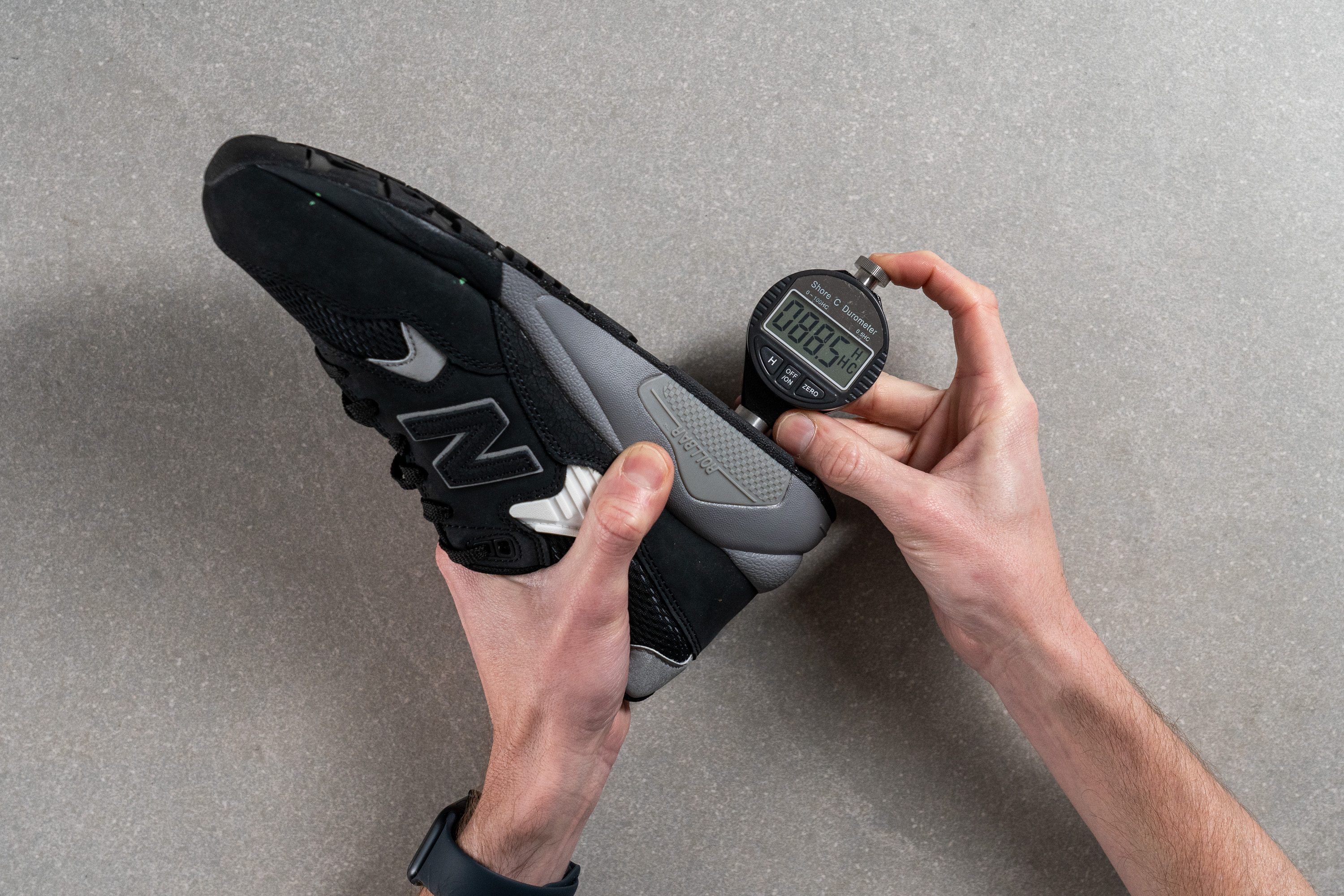
| 580 | 88.6 HC |
| Average | 85.7 HC |
Outsole durability
For our Dremel's final outing, we set its abrasive element to a more formidable 10K RPM and set it against the 580's outsole for twenty-two seconds.
Afterward, we used a tyre tread gauge to measure the indent left behind in the wake of the test and found that the shoe only lost 0.3 mm of rubber from the outsole. This makes the 580 much more durable than the average sneaker and means that we expect this timeless shoe to go out of style before the outsole goes.

| 580 | 0.3 mm |
| Average | 1.1 mm |
Outsole thickness
Using our caliper, we measured the 580's outsole to be 5.5 mm thick, putting it on par with our current lab average. This gives us plenty of material to wear through, especially considering how well the outsole performed in our test of extreme wear and tear.
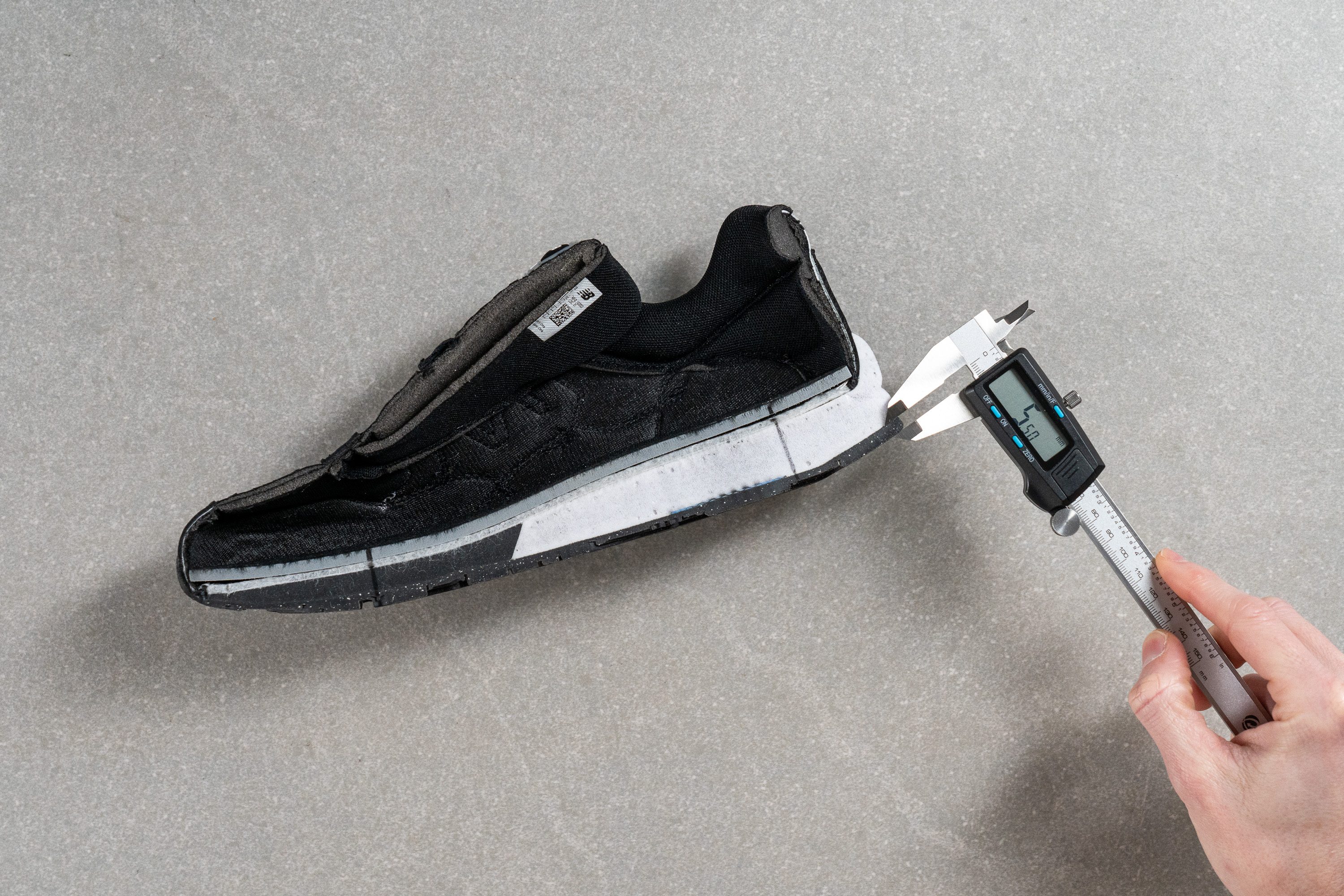
| 580 | 5.5 mm |
| Average | 5.3 mm |
Misc
Insole thickness
The 580's insole is 4.9 mm thick according to our caliper measurements, putting it on par with our current lab average. This gives us a welcoming footbed that effectively complements the midsole cushioning with every landing.
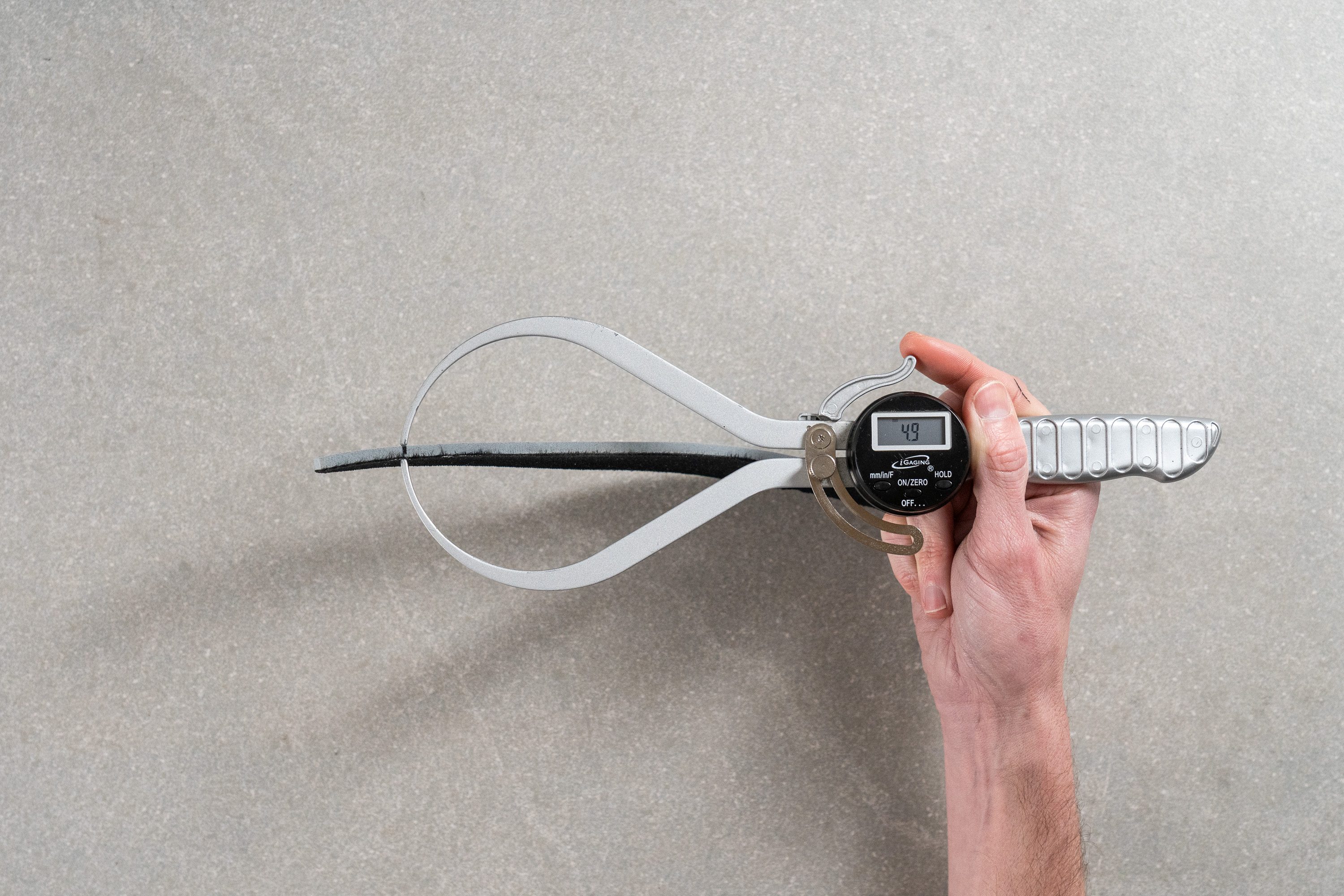
| 580 | 4.9 mm |
| Average | 5.1 mm |
Removable insole
The 580's insole isn't glued in so replacing it with an aftermarket alternative or a custom orthotic for added arch support is possible if necessary.
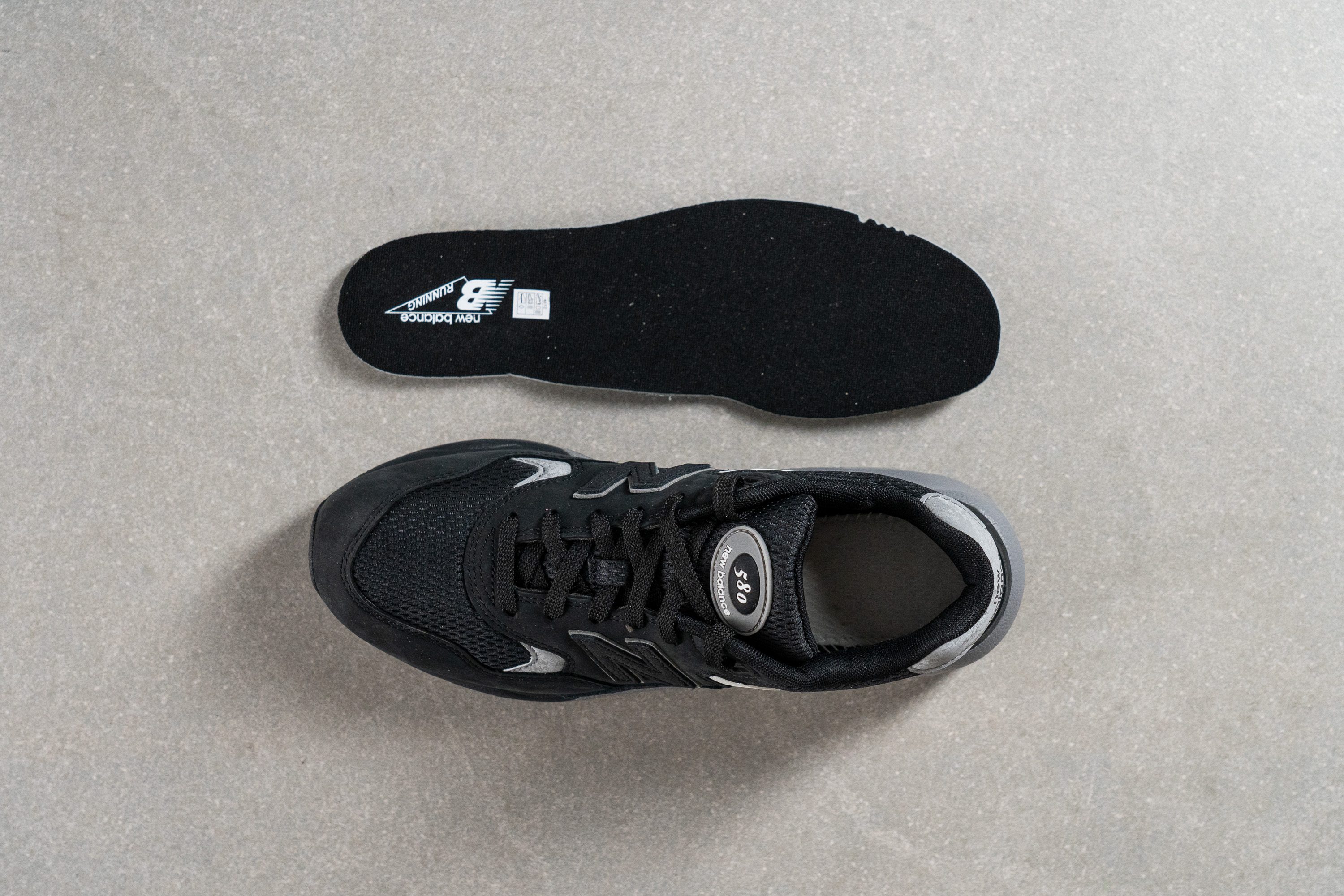
| 580 | Yes |
Reflective elements
The N insignias emblazoned on the sides of each shoe are outlined with a reflective lining that provides some nighttime visibility and looks pretty cool to boot.
| 580 | Yes |
Tongue padding
The 580 boasts a beefier-than-average tongue that we measured with our caliper to be 11 mm thick. This not only provides us with luxurious comfort across the instep but also aids in achieving a secure midfoot lockdown.
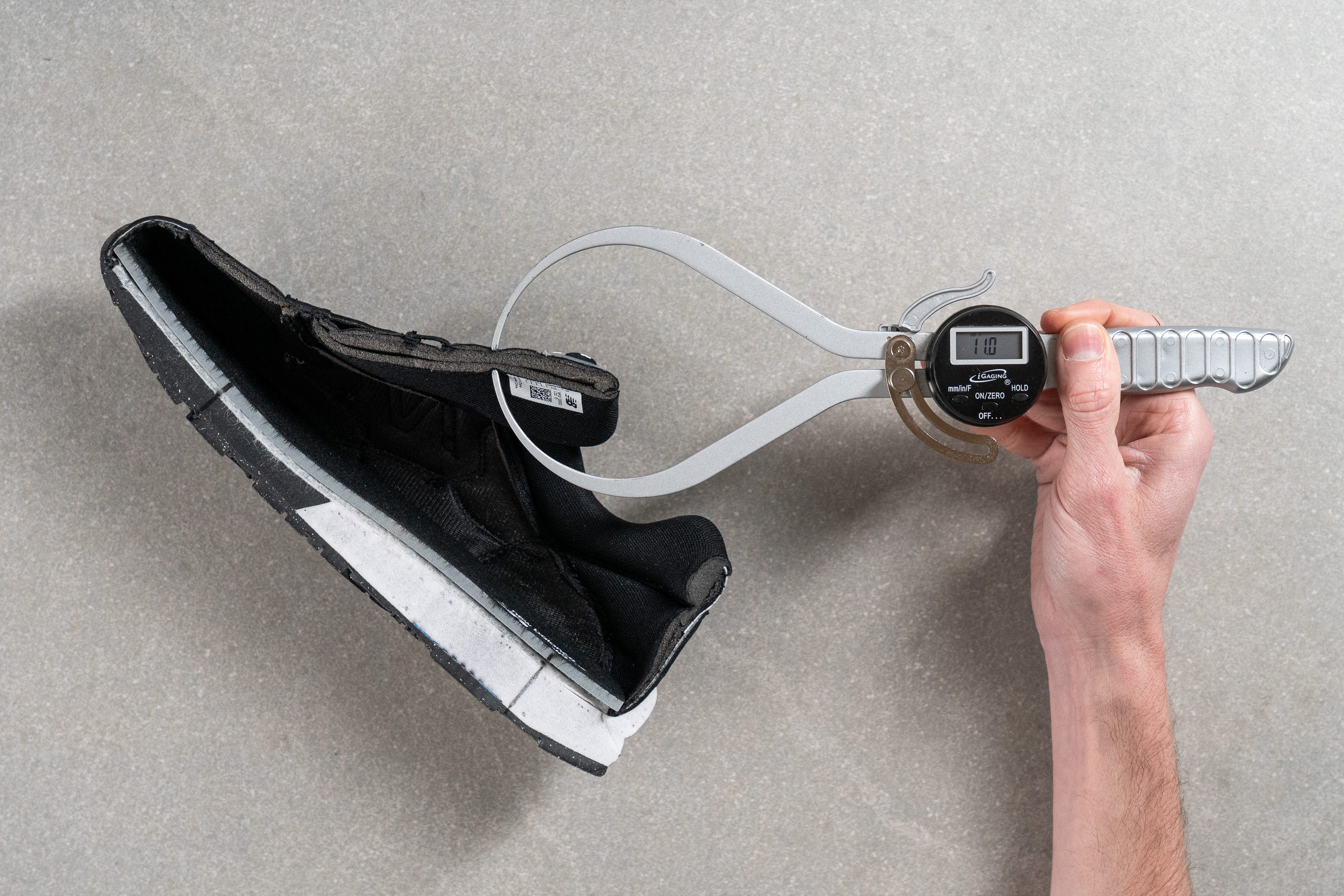
| 580 | 11.0 mm |
| Average | 9.6 mm |
Tongue: gusset type
Despite being non-gusseted, the chunkiness of the tongue along with the central lace loop keeps it from slipping to the side too much as we tested the 580.
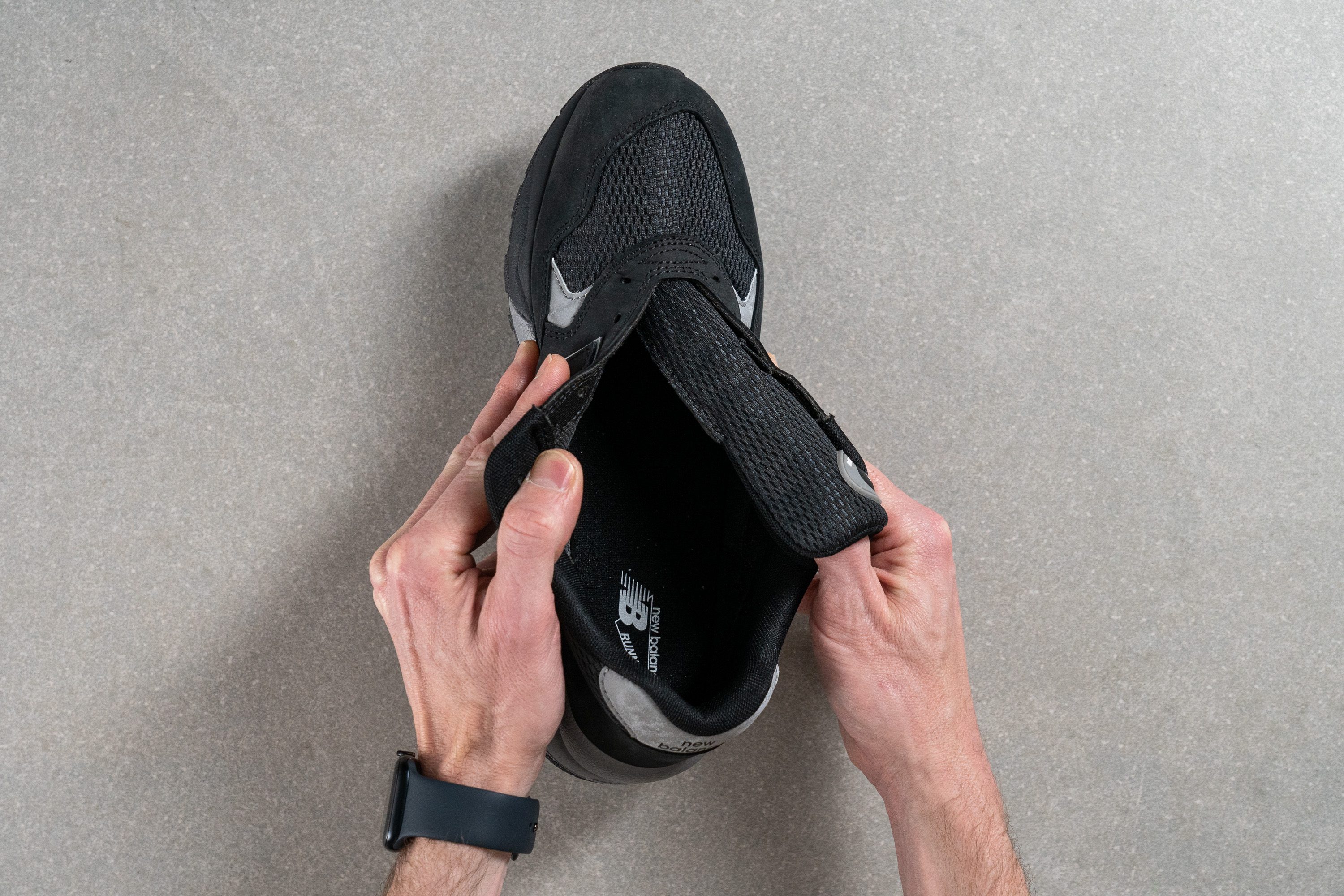
| 580 | None |

